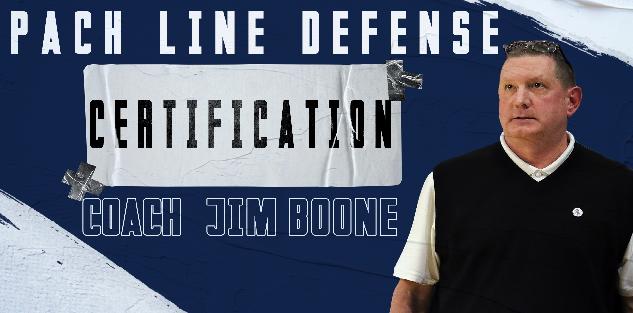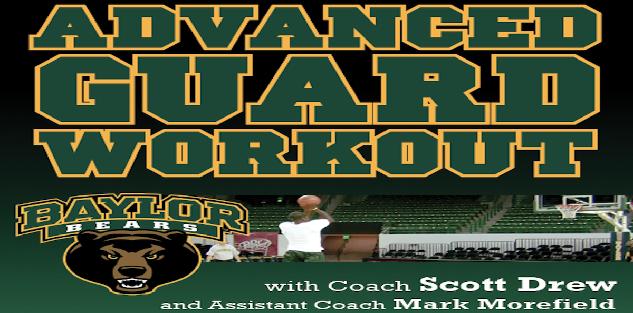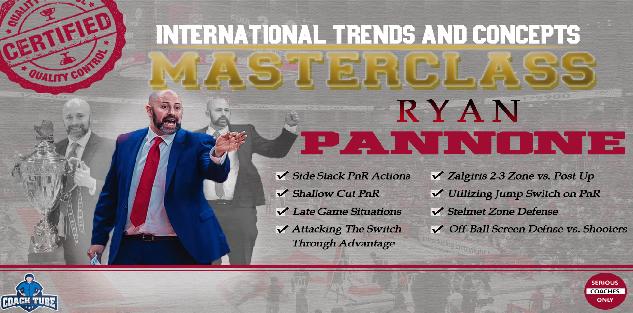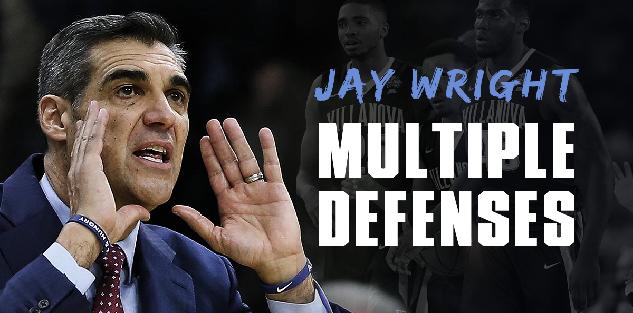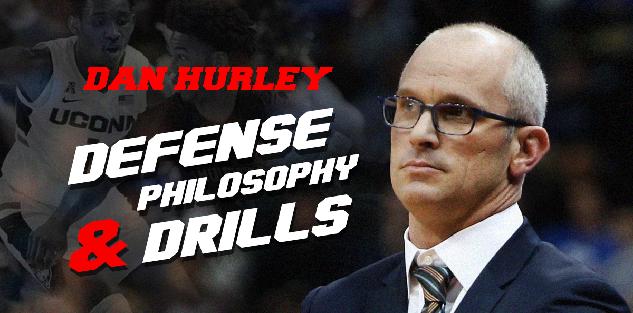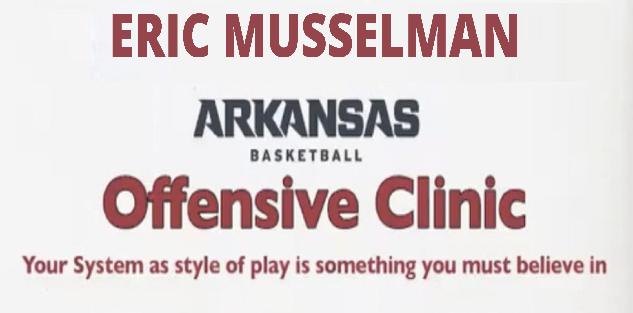Featured courses
- Two Great Game Situational Workouts For the Basketball Offseason by Grant Young
- Two Reads Basketball Players Must Understand Before Executing the Ball-Screen by Grant Young
- Two of LSU Coach Kim Mulkey’s Game-Winning Inbounds Plays by Grant Young
- Three Effective Early-Season Defensive Basketball Drills by Grant Young
- Four Essential Tips For Basketball’s 1-3-1 Zone Defense by Grant Young
- Four Zone Defense Drills to Strengthen Your Team by Grant Young
- How to Beat the Three Most Common Pick and Roll Coverages by Grant Young
- Two Drills to Improve Shooting at the Start of the Basketball Season by Grant Young
- Core Basketball Principles That Dallas Mavericks Coach Sean Sweeney Teaches by Grant Young
- Three Competitive Shooting Drills For Your Basketball Team by Grant Young
- How To Teach The ‘I’ Generation of Basketball Players by Grant Young
- Three Elite Drills to Begin a Basketball Practice With by Grant Young
- How to Build a Championship-Winning Basketball Team Culture by Grant Young
- Two of Texas Women’s Basketball Coach Vic Schaefer’s Tips For Team Culture by Grant Young
- Atlanta Dream WNBA Coach Brandi Poole’s Four Sets for Secondary Offense by Grant Young
- NC State Basketball Coach Brett Nelson’s 4 Crucial Point Guard Qualities by Grant Young
- Kentucky Coach Mark Pope’s Five Guard Rules For Offense by Grant Young
- McNeese State Basketball Coach Will Wade’s 4 Core Pillars by Grant Young
- 4 Tips To Instantly Improve Your Free Throw Shooting by Tyler Linderman
- Assemble a Championship-Caliber Basketball Rotation by Brandon Ogle
- Two of UConn Coach Dan Hurley’s Key Defensive Drills by Grant Young
- Four Post Moves All Basketball Forwards Should Have In Their Bag by Grant Young
- Four of Baylor Coach Nicki Collen’s Midseason Pick and Roll Adjustments by Grant Young
- WNBA Legend Sue Bird’s Two Tips For Attacking on Offense by Grant Young
- Houston Coach Kelvin Sampson’s Three Keys for Building a Basketball Program by Grant Young
- Two of Tom Izzo’s Top Michigan State Defensive Drills by Grant Young
- Four of Olympic Gold Medalist Coach Mechelle Freeman’s Relay Race Strategies by Grant Young
- Three Key Strategies Will Wade Uses to Build a Dominant Team by William Markey
- Five UConn Huskies Men’s Basketball Plays That You Can Use by Grant Young
- Three Tips for Maintaining Team Culture at the End of a Basketball Season by Grant Young
- Three Dribble Drive Motion Drills to Teach Your Basketball Team by Grant Young
- Three Dribbling Drills For Non-Primary Ball Handlers by Grant Young
- Four Advanced Ball Handling Drills For Basketball Guards by Grant Young
- Three Tips to Sharpen Your Post Player’s Footwork in Basketball by Grant Young
- These Three Pick and Roll Drills Are Crucial For Any Ball Screen Offense by Grant Young
- Three Closeout Drills to Improve Basketball Shooting Defense by Grant Young
- Three Tips to Perfect the Packline Defense in Basketball by Grant Young
- Four Keys to Executing the Read and React Offense in Basketball by Grant Young
- Three Tips to Develop Elite Basketball Shooters by Grant Young
- Three Crucial Keys to Executing the 5 Out Offense in Basketball by Grant Young
- These Three Offensive Sets Will Help You Beat Any Zone Defense by Grant Young
- Three Transition Basketball Drills To Play With More Pace by Grant Young
- Three 5 Out Offense Drills Any Basketball Coach Can Use by Grant Young
- Four Vital Techniques for a Motion Offense in Basketball by Grant Young
- Three Baseline Inbounds Plays To Win Your Basketball Team Games by Grant Young
- Four Drills For Sharpening the European Ball Screen Offense by Grant Young
- Three Positioning Tricks For a Basketball Zone Offense by Grant Young
- Three Rules to Perfecting Basketball's Lock Left Defensive System by Grant Young
- UCLA WBB Coach Cori Close’s Two Keys to Winning the Mental Game by Grant Young
- Four of Alabama Coach Nate Oats’ Favorite Basketball Drills by Grant Young
- Three Ways To Turn Transition Offense in Basketball Into Points by Grant Young
- Three Drills to Master Basketball's Pack Line Defense by Grant Young
- Three Transition Defense Drills to Halt Fast Breaks by Grant Young
- Four Offensive Rebounding Drills to Win Second Possessions by Grant Young
- 4 Defensive Technique Drills from Boston Celtics Assistant Coach Brandon Bailey by Marek Hulva
- 5 Drills to Improve Ball Handling by Tyler Linderman
- 13 FUNNY BASKETBALL GIFS by Alex
- BASKETBALL SPEED AND AGILITY: 8 QUESTIONS FOR COACHTUBE EXPERT RICH STONER by Jaycob Ammerman
- Defensive Strategies for Basketball by Ryan Brennan
- 4 Keys To Turning Your Program Into Championship Contender By Dallas Mavericks Coach Sean Sweeney by Marek Hulva
- 5 Components to Creating a Winning Basketball Program by Justin Tran
- Guide to Becoming a Lethal Scorer in Basketball by Justin Tran
- Zone Defense In the NBA Eastern Conference Finals by James Locke
- Mastering Court Mobility: Tips for Effective Movement in Basketball by Justin Tran
- 5 Basketball Shooting Drills: How to Develop a Sharpshooter by James Locke
- 6 Points of Emphasis for a Successful 5 Out Offense by Jaycob Ammerman
- Effective and Efficient Methods to Practice During the Basketball Season by Justin Tran
- Three Great Passing Drills From a Basketball Coaching Legend by Grant Young
- 7 Principles For Perfecting the Princeton Offense in Basketball by Grant Young
- How to Replicate A Modern NBA Offense by Grant Young
- Three Great Two-Ball Dribbling Drills For Basketball Development by Grant Young
- Two Rebounding Drills to Win Your Basketball Team Championships by Grant Young
- How to Improve Your Basketball Team’s Defense With the Shell Drill by Grant Young
- How Baylor Basketball’s Scott Drew Develops Elite Guard Play by Grant Young
- Off-Ball Movement Tips and Strategies: Lessons From the NBA Finals by James Locke
- Player Development: Scott Drew’s Tips for Producing NBA Guards by James Locke
- How to Execute a Spread Offense in Basketball by Grant Young
- Four Quality Quotes From Four Final Four Coaches by Grant Young
- A Guide to the Pack Line Defense by Alex Martinez
- 3 Defensive Build Up Drills to Improve Team Basketball Defense by Grant Young
- Battle of Two Great Coaches: Best Plays from the NBA Finals Contenders by Justin Tran
- 10 Creative Ways Athletic Programs Can Use a Video Board to Raise Money by Coach Williams
- How to Use 3 on 3 to Improve Your Basketball Team by Grant Young
- How to Defend the Pick and Roll by Grant Young
- Mastering Basketball Defense: Techniques, Drills, and Strategies for Success by Justin Tran
- Three Tips From The Coach Who Developed Giannis Antetokoumnpo by Grant Young
- 2023 NBA Draft: Skills and Technique from Top Prospects by Justin Tran
- From College to the Pros: Transitioning the Dribble Drive Offense by Justin Tran
- Positionless Basketball: Redefining Roles on the Court by Justin Tran
- Revolutionize Your Offense: Proven Concepts to Elevate Your Basketball Game by Justin Tran
- 5 Essential Fastbreak Drills Every Basketball Coach Should Know by James Locke
- How to Run a Circle Offense in Basketball by Grant Young
- Game-Changing Strategies: ATO Plays in the EuroLeague and Olympics by Justin Tran
- How to Stand Out at Basketball Tryouts by Grant Young
- How to Improve Your Basketball Team’s Transition Defense by Grant Young
- Indiana Fever GM Lin Dunn’s Two Keys For Women’s Basketball Coaches by Grant Young
- Strength Training Strategies Every Basketball Player Should Have by Grant Young
- A WNBA Basketball Coach’s Four Priorities In Transition Defense by Grant Young
- Three Adjustments to Make When Your Basketball Offense Isn’t Working by Grant Young
- Three Pillars to Applying Defensive Pressure on the Basketball Court by Grant Young
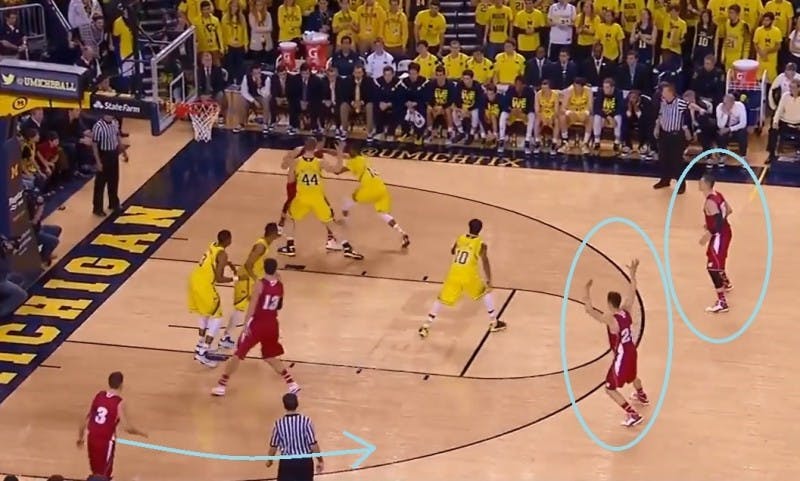
Four Vital Techniques for a Motion Offense in Basketball
- By Grant Young
Basketball’s modern motion offense is among the effective strategies that a basketball coach can employ for several reasons.
1. It emphasizes constant movement, spacing, and player interchangeability, which can create mismatches and open scoring opportunities.
2. It requires players to have a high basketball IQ and good decision-making skills, leading to a more dynamic and unpredictable offense.
3. The motion offense can exploit defensive weaknesses and adapt to different defensive strategies, making it a versatile and effective system in today's game.
Despite these clear benefits, some coaches and players may be hesitant to use the motion offense in basketball. There’s no question that it requires a high level of basketball IQ and an understanding of spacing and timing, which can be challenging to implement effectively.
Plus, some coaches may prefer more structured offensive sets and defined roles, finding the constant movement and decision-making of the motion offense overwhelming and difficult to effectively practice. Not to mention that transitioning to a motion offense requires time and commitment to teaching and learning the system, and finally, some teams may lack the personnel (such as versatile and skilled players) needed to fully maximize a motion offense’s potential.
While all of these concerns are valid, it won’t take Mark Cascio long to prove to you that switching to a modern motion offense is always a wise decision.
Mark Cascio is a championship basketball coach with 18 years of experience at the Division I and High School levels. During this time, his teams have won seven district titles, appeared in five Final Fours, and won a Louisiana State Championship in 2012. Coach Cascio was a head coach at the age of 21 and is the youngest coach to capture a state title in Louisiana at the age of 26. Mark’s tireless work ethic and quest to be a lifelong learner have provided him with resources he is eager to share.
Coach Cascio’s ‘The Modern Motion Offense’ course will have you learn how to keep what you love about motion while allowing for more player creativity, create more space, and use modern actions and triggers to create advantages, such as the two-sided break, zoom action, ball screens, split action, uphill DHOs, and more.
What is Modern Motion?
One rule that Coach Cascio believes is crucial for executing a modern motion offense is that his team will pass through single gaps in the defense and drive through double and triple gaps.
So if there are always single gaps on the floor, his team is always going to be passing, cutting, and setting screens, which will nearly always create space and an opportunity to either get the ball into the paint or facilitate an open shot at some point in the shot clock.
Another vital aspect of running a modern motion offense (as opposed to a more half-court-based traditional motion offense, which has more or less run out of style) is that teams need to be able to be free to run the ball up the court and execute transition offense when it presents itself.
In addition, given how prevalent three-point shots are in any modern offense, an important adaptation the modern motion offense needs is to have players more spread out along the perimeter rather than just standing right on top of the three-point line. This increased space will not only free up shooters but will create passing and cutting lanes that are crucial to getting shots near the basket in a modern motion offense.
While this may sound obvious, another integral part of running a modern motion offense is that the ball should perpetually be in motion.
Coach Cascio ensures this by employing what he calls a “.5 rule” on offense. This means anytime a player has the ball, they have half of a second to either shoot, dribble, or pass. This ensures that there is no stagnancy or isolation in the game, which typically facilitates mistakes from defenders and creates numerous scoring opportunities throughout a game.
Putting It All Together
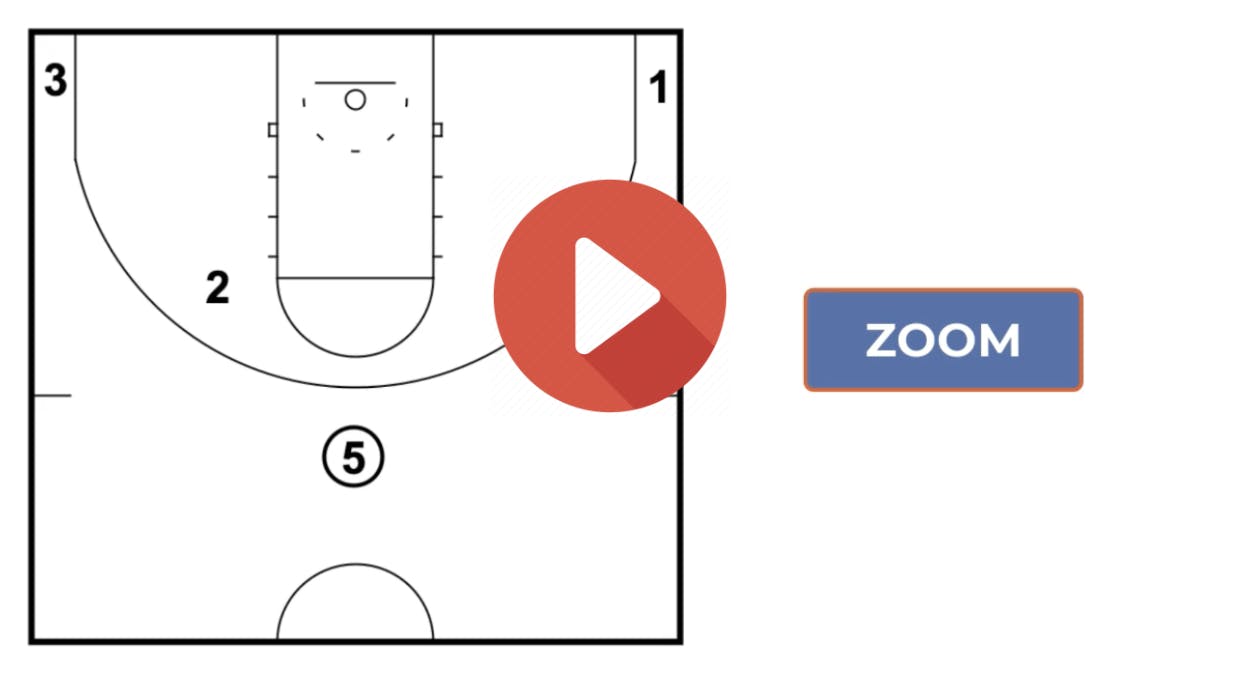
One of the best parts about running the modern motion offense is that it’s versatile enough for a coach to be able to tinker with some components to make it best fit their team philosophy or roster. For example, if a coach prefers off-ball screening to on-ball screening, then can lean on more zoom concepts instead of chasing into a ball screen on most possessions.
After your modern motion offense has created an advantage within a possession, the offense will want to drive, kick, space, and share the ball until a high-percentage, big advantage shot appears. A great aspect of this is that, after the advantage has been created, the players just need to play natural and free basketball (in other words, making the right play when it presents itself) and success more typically follows.
A common misconception with the modern motion offense is that it isn’t effective for post players, or teams that don’t have elite attacking guards or adept shooters on the wings. But given how the offense is constantly moving (especially if a team employs the aforementioned .5-second rule) post players should get some of the easiest scoring opportunities of their lives.
Post players can set back-screens for each other, which should create freedom along the baseline and perhaps get a mismatch. They can ball-screen (pick and roll), and create space outside of the key for their guards to drive into the paint and kick it out to them, which often makes for an uncontested mid-range jumper or touch shot that makes for easy baskets.

